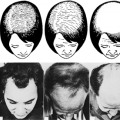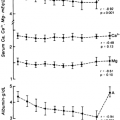ANAPLASTIC THYROID CARCINOMA
Part of “CHAPTER 41 – UNUSUAL THYROID CANCERS“
Anaplastic cancer is a rare, aggressive malignancy with mean survival rates of <1 year. These tumors are comprised of large, pleomorphic cells with mitoses and bizarre nuclei. The cytologic pattern can range from large cells to spindle cells that conform to a variety of different histologic patterns.2,3 All of these tumors share similar clinical characteristics; therefore, clinical presentation, management, and prognosis are considered together. In the past, small cell carcinomas of the thyroid were also considered a variant of anaplastic carcinoma; however, these have been reclassified as thyroid lymphomas, typically respond to lymphoma therapy, and are considered in a separate section.
DEMOGRAPHICS AND PATHOGENESIS
The annual incidence of anaplastic carcinoma is estimated to be two per million in the United States.4,5 Anaplastic carcinomas are more frequently identified in regions of iodine deficiency,6 and the incidence decreases with introduction of iodine prophylaxis. In all populations studied, the incidence rises with increasing age. Demographically, anaplastic thyroid cancer shows a predominance among females, with a median age of onset in the sixth and seventh decades.2,3 and 4,7
The pathogenesis of anaplastic thyroid cancer is not entirely clear. A stepwise “multi-hit” hypothesis for thyroid tumor dedifferentiation has been proposed,8 based on the high frequency of concurrent well-differentiated and anaplastic carcinoma, and epidemiologic data showing that as many as 30% of patients with anaplastic cancer have a history of well-differentiated carcinoma.2,3 and 4,7 In support of this model, poorly differentiated thyroid tumors have a higher incidence of mutations of the genes encoding p53, other tumor suppressors, and oncogenes associated with aggressive cancers. Thus, the general belief is that anaplastic thyroid cancers rarely occur de novo.
Other factors proposed to be involved in the development of anaplastic thyroid cancer include a history of neck/mantle external radiation and prior iodine-131 (131I) therapy. Although it is associated with development of nodules and hypothyroidism, no convincing data other than several case
reports exist linking external irradiation to anaplastic thyroid cancer. Similarly, 131I therapy does not appear to cause anaplastic thyroid cancer.9
reports exist linking external irradiation to anaplastic thyroid cancer. Similarly, 131I therapy does not appear to cause anaplastic thyroid cancer.9
CLINICAL PRESENTATION AND DIAGNOSIS
Patients with anaplastic cancer classically tend to be older, with a prior history of multinodular goiter that manifests as a rapid enlargement of a nodule or appearance of a lymph node and is characterized by severe pain, dysphagia or odynophagia, and airway compression. The rapid enlargement is often due to hemorrhage into a preexistent tumor.2,3 and 4,7 Superior vena cava syndrome from extensive cervical disease and/or symptoms from distant metastases are sometimes present at initial evaluation. Dense fibrosis and calcifications are also well described.10 Anaplastic carcinoma can also be found in more typical nodules that are not rapidly enlarging and within large compressive multinodular goiters that do not have the rapid enlargement noted above.
Stay updated, free articles. Join our Telegram channel

Full access? Get Clinical Tree





